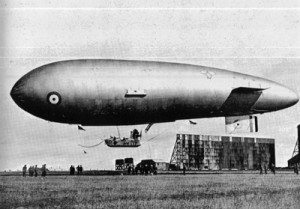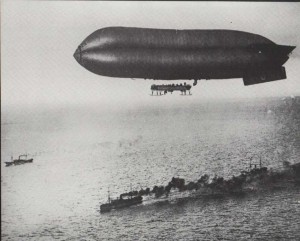
THE SECOND OFFICER –
Without doubt, Arthur Stanley Elliott had an interesting career in the airship service. Known as an unlucky airshipman he certainly had his fair share of bad luck.
Arthur was born on 18 February 1894 in Halifax, Yorkshire. His permanent home address is recorded as Charleston, Bridlington, Yorkshire. Before he joined the Royal Naval Air Service, Elliott was a junior officer in the Merchant Navy. Elliott was posted to Wormwood Scrubs on 2 January 1916 and then the Clement Talbot Works (RNAS Armoured Car Division) Wormwood Scrubs.
According to his service record Elliott is listed as ‘sick’, but obviously recovers and is transferred to Anglesea on 28 June 1916. Here he flew Submarine Scouts (mainly SS 24) until SS Pusher (SSP 5) arrived.
Elliott carried out first trial flight of SSP 5 at Wormwood Scrubs on 11 May 1917, and delivered her to Anglesey via Cranwell on 13 May. Was then in sole command until the end of May when he was posted to Mullion for service on ‘coastal ships’ and is recorded to have flown on C2 on 21, 22 and 26 June 1917.
On 30 June 1917 Elliott was promoted to Flight Lieutenantand made the first flight of SSZ 14 on 28 July, 1917, at Mullion, and was then the pilot of every flight up to and including the 14 hours free balloon flight to Montreuil, in France, on 22 October, 1917.
On 7 September 1917, SSZ-14, under the command of Flt. Lt Elliott, set out on patrol from Mullion. J. A. Sinclair in Airships in Peace & War (published 1934) gives an account of what happened during this flight…
“Much credit must be given to our airship men for their skilful handling of their highly-experimental craft in times of emergency. The SSZ 14 is a case in point. She left Mullion on 7 September, 1917, at 9.05 am, and proceeded on her patrol. At 4.25 pm the engine suddenly stopped. All efforts to restart her were unsuccessful. The ship signalled engine trouble and gave her position. At 4.35 she had risen to 2,500 feet and was drifting in a SSW direction. An hour later the drogue was accidentally dropped overboard, but a suitable and efficient substitute was soon made out of a chair, coats and petrol tins.
“The Lewis gun was then thrown overboard to prevent the ship from hitting the water, as by this time she had descended to a very low altitude. At 5.45 the sun came out again and the ship rose to 3,500 feet. At 6 pm she was brought down to 100 feet and further efforts were made to restart the engine, but without result. The drogue worked very well, however, keeping the craft shearing just off the wind, and at 6.35 she was drifting south, some forty miles south of Start Point.
“Lifebelts were then given out to the crew, and at 6.45pm the ammunition trays, revolvers and pyrenes were thrown overboard. Between 6.55 and 7.35 positions were received from the Lizard, and Brest was informed. At 7.35 cartridges and the cover of the Aldis lamp were thrown out, oil was drained from the tank, and later the water was drained out of the radiator and the petrol was run into the ballast bags. The explosives were taken out of the bombs and thrown overboard.
“At 8.57 pm the ship reported to the Lizard that she was over land, and at 9.15 she landed near St. Jean du Doight, Finistere, having used all ballast. There she was deflated and taken by wagon to Guipavas Airship Station, where, with the assistance of the French, the crew re-inflated her, and on 21st she flew back to her station. No damage was done and no spares were required. She had free-ballooned a distance of approximately 120 miles – thanks to the very efficient adjustments made from time to time throughout the forced trip by her pilot, Flt. Lt. Elliott.”
The less eventful flight from Guipavas Airship Station, close to Brest, back to Mullion took 3 hours, 40 minutes.
On 1 October 1917, Arthur Stanley Elliott was awarded the Distinguished Services Cross for he had …“displayed exceptional merit in his performance of patrol duties, having carried out 36 patrols, duration not less than 1 1/2 hours.”
On 27 October 1917, SSZ.14 took another unplanned trip to France. The engine shaft broke causing the ship to drift in a 14-hour free balloon flight across the English Channel again. The airship landed at Montreuil, Pas-de-Calais, headquarters of the British Army in France – 300 miles from its base at Laira in Cornwall.
Records show that Elliott flew on Coastal airship C9 on 21, 23 and 26 December 1917. C9 was, at this time, under the command of Flt Lt T.P. York-Moore.
On 1 January 1918 Elliott was awarded the Distinguished Service Cross for patrol duties and submarine searching in home waters. The same day he was given command of the Submarine Scout SS-Z 25. With a crew of four and fitted with machine guns these airships were very popular with their crews. On 4 January the airship was sent to Laira mooring out station in Cornwall. Unfortunately, on 20 January SS-Z 25 broke free from her moorings in a gale at Mullion and was wrecked. Elliott had only spent 42 hours in her.
On 25 April 1918 Elliott, together with A.M. Johnson (Engineer) and B. M. Cusons (W/T) took charge of SSZ 42 at at Wormwood Scrubbs to deliver it to Mullion via Polegate in East Sussex. On 26 April the airship became heavy and he was forced to land at Ilford Camp near Christchurch, Dorset. The airship was delivered to Mullion by rail.
The bad luck didn’t end there. While being piloted by Elliott for the first time, Coastal airship C23A became very heavy while on patrol off Newquay, fell into the sea and was wrecked on 10 May 1918. The wireless operator A.W.Robinson was drowned but Elliott, AM1 D.F.Corsbie (Observer), LM R.T. Youngman (Coxwain) and AAM1 A.E.Oakley (Engineer) were saved. The wreck was towed into Newquay and salvaged – it was discovered that the after crab-pot had carried away which caused the envelope to deflate. Before the incident C23A had been continuously inflated for 11 months and had done just under 1,000 hours flying – this had been cause for concern as great difficulty had been experienced in handling her in bad weather.
Just six days later, while in command of SSZ 45, Elliott’s bad luck continued. Whilst returning from patrol over Gunwalloe, a fishing cove in Cornwall, the rudder controls jammed and all efforts failed to release them. Elliott ballasted the ship up so she was just light, and came down on his drogue. The airship was then hauled down on the beach, landed, and the rudder temporarily repaired. They then flew on safely to Mullion. Elliott and his crew flew SSZ 45 for a total of 128 hours, 55 minutes until the remainder of May. On 2 June the airship was flown the mooring-out site at Laira near Plymouth back to Mullion owning to loss of gas purity due to a defective envelope and was deflated.
Elliott flew on Coastal airship C9 from 13 to 31 August 1918 (but not every flight), and C2 from 18 to 28 September and 11 October 1918. From this point he seems to have be moved from Mullion to take over temporary command of RN Airship Station Bude for a month and then moved between the SW Area headquarters in Plymouth; Bude; Mullion; and then Pulham on 25 March 1919. His records show he was graded for purposes of pay and allowances as Capt. (Airship) from 14 August 1918 to 18 March 1919. He is the show to have been posted to Pulham Air Station on 27 June 1919 and then “Capt Airship NS fly duties” on 12 July 1919. The next entry reports “Died as result of airship accident 15/7/19.”
Arthur Stanley Elliott left a wife called Hazel who was living in Harleston, Norfolk at the time. According to George Meager AFC who was at Anglesea with Elliott, she was “an exceedingly pretty girl” 1. The best match in the marriage records is Margaret Hazel Lloyd with a wedding early 1917 – known as Hazel Margaret Elliott in the announcement of Arthur’s will in April 1920.
However, according to Captain T. B. Williams, Hazel was a daughter of the Trevor-Williams family from Llangefni in Anglesey “who kept an open house for airshipmen based there”. Elliott was a flying partner of Captain T. B. Williams at Anglesea, who had the sad task of breaking the news of Elliott’s death to her.2
1. From Captain George Meager’s book My Airship Flights 1915-1930
2. From Captain T. B. Willams’ book Airship Pilot No.28



 NS11 – As Bright As Day is very much a work in progress and has been made possible by the generous and enthusiastic support of many individuals and organisations. If you have any information, records or material relating to British NS Class airships we would be very interested to hear from you – especially anyone related to members of the crew of NS11 or any airship of the class during their service with the RNAS or RAF during and beyond WWI.
NS11 – As Bright As Day is very much a work in progress and has been made possible by the generous and enthusiastic support of many individuals and organisations. If you have any information, records or material relating to British NS Class airships we would be very interested to hear from you – especially anyone related to members of the crew of NS11 or any airship of the class during their service with the RNAS or RAF during and beyond WWI.
Latest